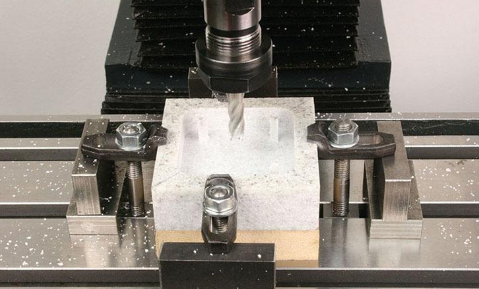CNC Milling Constant velocity mode
Some experimentation may be needed, initially, to work out the settings that best suit most jobs. Fig. 6-10 shows a rectangular pocket that has been machined with too great a tolerance on the extent to which the path of the Controlled Point may deviate from the specified points. The priority in this case was in favour of speed at the expense of the exact path (G64), but this has resulted in the actual path missing some areas, leaving four columns of material in what was supposed to be a cleared-out pocket. Reducing the tolerance by reducing the P value in the G64 P~ command resolved the problem while maintaining a decent speed.
So, the best way to deal with complex 2D shapes consisting of polylines is by drawing the shape in a CAD program, or a compatible vector drawing program, then employing CAM software that uses the mathematical definitions of the poly- lines to calculate the path for the Controlled Point. The output is G code suitable

for the CNC program to drive the mill, but the way in which the CNC program fol- lows the instructions will depend on the G61/G64 commands. Like the linear shapes in Chapter 5, shapes made with polylines will be profiles or pockets, or combinations of the two, and the same methods can be used to calculate the toolpaths. For 2D shapes, Cut2D will output G code to allow complex shapes to be ma- chined. Shapes can be drawn directly in Cut2D, so that it acts as the CAD program before taking information about the cutter and calculating the toolpath. For poly- lines, however, Cut2D is restricted to drawing straight line segments. Its big broth- ers, VCarve Pro and Aspire, have a more extended set of drawing tools; although you may prefer to use a fully featured drawing program such as Adobe Illustrator, save the drawing and then import it into your CAM program. Draw the shape shown in Fig. 6-11 directly within Cut2D. Define the material as 50 × 100mm, 1.6mm thick, with the X, Y origin at the bottom left corner.